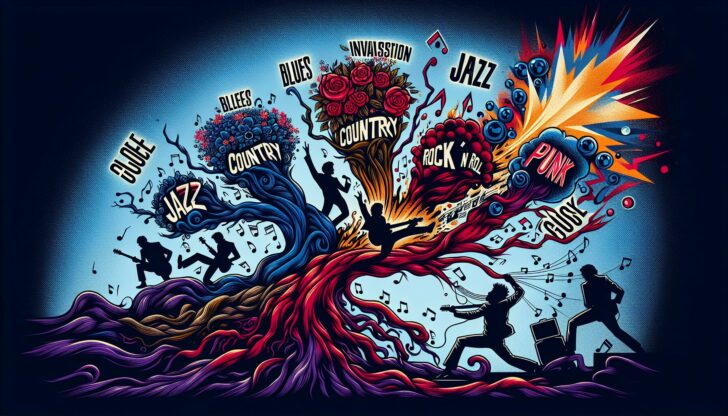Rock music has produced some unforgettable tracks that have defined generations. In this article, we dive into the all time best rock songs that have left an indelible mark on the genre. Expect a journey through different eras, from the birth of rock ‘n’ roll to the modern classics, showcasing the songs that truly stand the test of time.
Table of Contents
Key Takeaways
Rock music evolved from a blend of rhythm and blues, country, jazz, and gospel, shaped by innovators and landmark songs like Elvis Presley’s ‘Heartbreak Hotel’ and Chuck Berry’s narratives of teenage dreams.
Iconic rock tracks such as Led Zeppelin’s ‘Stairway to Heaven,’ Queen’s ‘Bohemian Rhapsody,’ and Eagles’ ‘Hotel California’ have become timeless classics, resonating through generations with their unique musical and lyrical qualities.
Female rock pioneers like Joan Jett, Janis Joplin, and Stevie Nicks have significantly impacted the genre by breaking norms and redefining the role of women in rock, inspiring new generations of musicians.
The Evolution of Rock Music

Rock music, a genre that revolutionized the cultural landscape, began as a melting pot of rhythm and blues, country, jazz, and gospel—each strand weaving into the explosive tapestry that became rock ‘n’ roll. It was a fusion accelerated by the electric guitar and recording innovations, birthing a sound that would echo through the ages. What followed was a series of evolutions, each marked by its pioneers and iconic anthems.
From the early rock gods to the punk rock rebels and the heavy metal titans, each movement added new chapters to the storied rock history, creating a genre as diverse as it is dynamic.
The Birth of Rock ‘n’ Roll
Imagine a world before rock ‘n’ roll—a landscape waiting to be painted with the colors of rebellion and rhythm. It was the early 1950s when this vibrant musical genre sprang to life, shaking the foundations of popular culture. The airwaves hummed with the sounds of:
Bill Haley and His Comets as ‘Crazy Man Crazy’ hit the pop charts
‘Rock Around the Clock’ later became the first rock and roll song to top the charts in the US and UK
Elvis Presley’s ‘Heartbreak Hotel’ struck, heralding a new era led by a swiveling-hipped sensation from Memphis, you crazy diamond.
Elvis, discovered by record producer Sam Phillips, embodied the sound of African American blues in a way that captivated audiences across racial lines. He was part of a pantheon of rock pioneers like:
Chuck Berry, whose tales of girls and cars became the soundtrack to teenage dreams
Little Richard, whose flamboyant showmanship broke all the rules
Sister Rosetta Tharpe, who laid the foundation for the rock n roll phenomenon
These artists, including Guns N Roses, set the stage for everything that rock music would become.
The British Invasion
As rock ‘n’ roll matured, its rebellious spirit leapt across the Atlantic, finding a new voice in the hands of British bands. The Beatles’ historic appearance on ‘The Ed Sullivan Show’ in 1964 marked the beginning of the British Invasion, a musical movement that would redefine rock music. Bands like The Rolling Stones, with their gritty, blues-infused sound, dominated the American music charts and brought a fresh dynamism to the genre.
This was a time of cultural exchange and exploration, as British musicians drew inspiration from American blues and rock ‘n’ roll, then infused it with their distinct flair. The impact was profound, with bands like The Beatles evolving from love-struck crooners to psychedelic philosophers, pushing the boundaries of what rock music could be. These British rockers not only conquered the charts but also captured the imagination of a generation, leaving an indelible mark on rock history.
The Rise of Punk Rock
Fast forward to the 1970s, and a new revolution was brewing—punk rock. This movement was an explosive reaction to the perceived excesses of mainstream rock, stripping music back to its raw, unvarnished core. With a DIY ethos and breakneck tempos, bands like The Ramones and The Clash captured the zeitgeist of disaffected youth, giving voice to their frustrations and yearnings.
Punk’s raucous energy and do-it-yourself approach made it more than just music—it was a cultural force, challenging norms and questioning authority. The Kinks’ ‘All Day and All of the Night,’ with its raw sound, hinted at the shape of things to come, laying the groundwork for a genre that would redefine the spirit of rock ‘n’ roll for a new era. Punk rock wasn’t just about the music; it was an attitude, a stance against complacency, and a clarion call for change that resonated around the world.
Iconic Classic Rock Songs
In the vast panorama of rock music, certain songs stand as towering monuments—classic rock anthems that have become the anthems for generations. Among these tracks, one can find the greatest rock song that didn’t just climb the charts; it captured our collective imagination, with guitar riffs and lyrical poetry that have become part of our very identity. They’re the songs we scream at concerts, blast on road trips, and turn to when we need to feel alive.
Let’s explore some of these timeless masterpieces, from the mystical allure of ‘Stairway to Heaven’ to the operatic grandeur of ‘Bohemian Rhapsody’ and the haunting narrative of ‘Hotel California.’
“Stairway to Heaven” by Led Zeppelin
‘Stairway to Heaven’—a song that needs no introduction, yet its majesty beckons us to explore its every layer. Released on Led Zeppelin’s fourth album in 1971, this epic track unfolds like a musical odyssey, spanning the sonic spectrum from fairytale acoustic folk to blues-based hard rock. It begins with Jimmy Page’s delicate finger-picked arpeggios, soon joined by John Paul Jones’ mellotron recorders, creating an atmosphere of ethereal serenity.
As the song progresses, John Bonham’s drums transition the piece from tranquility to a gripping, steady groove, building up to a soaring interlude that propels the song into hard rock immortality. Lyrically, ‘Stairway to Heaven’ traverses themes of duality and introspection, delivered with a blend of vagueness and passionate intensity that invites endless interpretation. This is the essence of a classic rock song—timeless, evocative, and endlessly compelling.
“Bohemian Rhapsody” by Queen
When Freddie Mercury penned ‘Bohemian Rhapsody,’ could he have known he was creating one of the greatest rock songs of all time? Queen’s magnum opus is a masterpiece of musical innovation—a six-minute suite that defies genre and convention. From its haunting a cappella introduction to the operatic grandeur of its middle section, the song takes listeners on a journey through a kaleidoscope of sound and emotion.
Despite initial mixed reviews, ‘Bohemian Rhapsody’ has grown to be an anthem that spans generations, celebrated for its daring complexity and theatricality. Its impact was amplified by its groundbreaking music video, which helped to popularize the visual art form and marked ‘Bohemian Rhapsody’ as a turning point in rock history. This was not just a song—it was a performance, a declaration, and an experience that continues to captivate and inspire.
Learn more, visit Queen | Members, Songs, Albums, & Facts.
“Hotel California” by Eagles
‘Hotel California’ by the Eagles is a song that transports us to a place of golden sunsets and dark secrets, a rock ballad wrapped in a riddle. The song’s narrative, which tells of a traveler ensnared in a luxurious but sinister hotel, is ripe with themes of hedonism and the perils of excess—a reflection of the 1970s California rock scene, some would say. Yet, it’s the song’s iconic guitar solo that truly cements its legendary status, a harmonized duel between Don Felder and Joe Walsh that soars high into the pantheon of rock history.
The beauty of ‘Hotel California’ lies in its allegorical depth and musical craftsmanship. It’s a cautionary tale set to a tune that’s as bewitching as the story it tells. As listeners, we’re drawn into its mystery, compelled by the allure of the unknown and the seductive pull of a narrative that feels both intimate and universal. This is classic rock at its most evocative, a song that continues to resonate long after its final notes fade away.
Legendary Guitar Solos

The guitar solo—a moment where time seems to stand still, and all that exists is the guitarist and their instrument, locked in a dance of emotion and skill. It’s in these solos that rock music reaches its zenith, showcasing the virtuosity and passion that define the genre.
From Gilmour’s haunting melodies to Hendrix’s revolutionary techniques, these guitar solos are more than just impressive technical feats; they’re the heart and soul of some of the greatest rock songs ever written.
“Comfortably Numb” by Pink Floyd
David Gilmour’s guitar solos in ‘Comfortably Numb’ are often hailed as some of the greatest ever recorded—an auditory journey through the depths of the soul. The song’s iconic solos are a masterclass in emotion and technique, from the ethereal picked harmonic that begins the first solo to the soaring phrases of the final, climactic guitar work. Gilmour’s distinctive tone, achieved by a combination of his picking position and the use of a Stratocaster’s front pickup, resonates with a clarity and depth that is as haunting as it is beautiful.
The solos in ‘Comfortably Numb’ are a testament to Gilmour’s mastery of the guitar, blending improvisation with careful composition to create a piece that is both technically brilliant and deeply moving. The solos, set against the backdrop of Pink Floyd’s swirling, psychedelic organs, and a narrative that is both stark and enigmatic, elevate the song from a mere track to an epic musical experience. It’s the kind of solo that speaks to the listener, conveying a story without words, and leaving an indelible mark on the landscape of rock music.
“Purple Haze” by Jimi Hendrix
Jimi Hendrix transformed the rock landscape with his unparalleled guitar work, and nowhere is this more evident than in the iconic ‘Purple Haze’ solo. His use of the E minor blues scale not only contributes to the song’s distinctive sound but also showcases a distinct blend of blues and psychedelia that became Hendrix’s signature. Standard tuning, which was less common for Hendrix, allowed the raw power of ‘Purple Haze’ to shine through, making it a revolutionary track in rock history.
The song’s solo is a masterful display of Hendrix’s innovative techniques, combining blues-based pentatonic scales with effects that were groundbreaking at the time. ‘Purple Haze’ not only solidified Hendrix’s place as a guitar god but also pushed the boundaries of what the electric guitar could do. It was a solo that went beyond mere notes on a scale; it was a declaration of artistic freedom and a blueprint for the future of rock guitar solos.
“Free Bird” by Lynyrd Skynyrd
‘Free Bird’ by Lynyrd Skynyrd is synonymous with the phrase “guitar solo,” thanks to its extended, multi-layered outro that takes listeners on a soaring journey. Originally added to give vocalist Ronnie Van Zant a break during live performances, the solo’s 143 bars of electrifying guitar work became the song’s heart and soul. Allen Collins, wielding his 1964 Gibson Explorer, crafted a solo that has come to define Southern rock’s expansive and virtuosic style.
What begins as a heartfelt ballad transforms into an epic showcase of Collins’s guitar prowess, with a solo that weaves through peaks and valleys of intensity and emotion. It’s a testament to the power of improvisation and the magic that can happen when a band, like the Allman Brothers Band, is truly in sync. ‘Free Bird’s’ solo is not just a moment in a song; it’s an experience, a rite of passage for rock fans that captures the spirit of freedom the song’s title evokes.
Influential Rock Anthems

An anthem is more than just a song—it’s a rallying cry, a collective shout from the rooftops declaring our shared experiences, dreams, and challenges. Influential rock anthems resonate with such power and passion that they become a part of our lives, echoing through stadiums, across airwaves, and within the walls of our homes. They are the songs that define moments, movements, and memories, packed with energy and intensity that unite us all.
“Born to Run” by Bruce Springsteen
Bruce Springsteen’s ‘Born to Run’ is a rock anthem that encapsulates the restless spirit of youth and the longing for something greater. Released in 1975, it paints a vivid picture of escape and the pursuit of freedom, with Springsteen’s impassioned vocals and the E Street Band’s driving sound creating a sense of urgency and hope. The song captures the universal desire for adventure and a better life, speaking to anyone who has ever dreamed of:
breaking free from the shackles of their surroundings
chasing their dreams
finding their place in the world
defying expectations
embracing their true selves
From the opening lines, ‘Born to Run’ grabs hold of the listener and doesn’t let go. The song’s depiction of youthful dreams and the desire to run towards a brighter future is as relevant today as it was when it first hit the airwaves. Springsteen’s storytelling prowess and the anthemic nature of the music combine to create a song that isn’t just heard—it’s felt. It’s a testament to the power of rock music to inspire and to articulate the feelings that lie deep within our hearts.
“Smells Like Teen Spirit” by Nirvana
When ‘Smells Like Teen Spirit’ burst onto the scene in 1991, it signaled a seismic shift in the rock landscape. This anthem by Nirvana captured the angst and disillusionment of a generation, bringing the raw sound of grunge from the underground to the mainstream. With its aggressive guitar chords, anthemic chorus, and Kurt Cobain’s gritty vocals, the song became a defining sound of the early ‘90s alternative rock scene.
‘Smells Like Teen Spirit’ resonated with listeners not just for its catchy riff but for its embodiment of the spirit of Generation X—disenchanted, restless, and yearning for authenticity. Nirvana’s breakout hit became an anthem for those who felt misunderstood and marginalized, a song that expressed their collective frustrations and desires. Its raw energy and powerful lyrics struck a chord with audiences worldwide, cementing its place in rock history and proving that a rock song could still change the world.
“We Will Rock You” by Queen
Queen’s ‘We Will Rock You’ is an anthem that needs no introduction, a song that has reverberated through stadiums and arenas for decades. With its iconic stomp-stomp-clap beat and call-and-response lyrics, the song is a masterclass in simplicity and power, crafted by guitarist Brian May to engage and energize crowds like never before. It’s the kind of song that transcends age, culture, and geography, becoming a universal declaration of defiance and unity.
The song’s enduring popularity lies in its ability to bring people together, serving as a soundtrack for sporting events, political rallies, and moments of collective celebration. ‘We Will Rock You’ is more than just a song—it’s an experience, a phenomenon, and a testament to the enduring appeal of Queen and the timeless power of a great rock anthem. It’s a song that, once heard, is never forgotten, echoing in our ears and in our hearts long after the last clap has faded away.
Pioneers of Heavy Metal
The world of heavy metal is one of thunderous riffs, dark themes, and a relentless drive that pushes the boundaries of rock music. Born from the ashes of the classic rock era, heavy metal’s pioneers crafted a genre that was louder, harder, and more intense. Bands like Black Sabbath, Metallica, and Motörhead didn’t just play music; they created a sonic assault that thrilled, shocked, and awed, giving rise to a new breed of rock that would dominate the world.
“Iron Man” by Black Sabbath
Few songs embody the essence of heavy metal quite like Black Sabbath’s ‘Iron Man.’ With its pounding drums and Tony Iommi’s iconic, crushing riffs, the song has become a cornerstone of the metal genre, defining its sound and attitude. Ozzy Osbourne’s vocals, belted out with a mix of menace and mystery, tell the tale of a man turned to steel, creating an atmosphere that is both eerie and electrifying.
The narrative of ‘Iron Man,’ conceptualized by bassist Geezer Butler and brought to life by Osbourne’s suggestion of the ‘Iron Bloke,’ is a science fiction story set to music that’s as heavy as the protagonist himself. It’s a song that captures the imagination, combining fantastical lyrics with a sound that was unlike anything heard before.
‘Iron Man’ didn’t just put Black Sabbath on the map—it paved the way for countless bands to follow, cementing the band’s place in rock history as true metal gods.
“Enter Sandman” by Metallica
Metallica’s ‘Enter Sandman’ roared onto the scene in 1991, propelling the band to new heights of fame and marking a pivotal moment in the evolution of heavy metal. The song’s opening riff, a menacing cascade of guitars, is instantly recognizable, becoming synonymous with Metallica’s powerful and polished sound. Layered with three tracks of rhythm guitar, the song builds a ‘wall of guitars’ that is both imposing and irresistible.
From the foreboding opening chords to the relentless drive of the drums, ‘Enter Sandman’ is a masterclass in metal music, combining technical prowess with a sense of theatricality that is quintessentially Metallica. It’s a song that captures the essence of the band’s innovative spirit, a track that not only dominated the charts but also expanded the possibilities of what heavy metal could be. This was Metallica at their most accessible and most powerful—a combination that would cement their status as rock legends.
“Ace of Spades” by Motörhead
Motörhead’s ‘Ace of Spades’ is the quintessential speed metal anthem, a high-octane powerhouse of a song that races along at breakneck speed. Released in 1980, it’s a track characterized by its:
ferocity
intensity
Lemmy Kilmister’s growling vocals
relentless tempo
These elements make ‘Ace of Spades’ an exhilarating ride from start to finish. The song laid the groundwork for the speed metal genre and influenced countless bands that would follow.
‘Ace of Spades’ is more than just a song; it’s an attitude, a way of life that embodies the spirit of Motörhead and the very essence of heavy metal. It’s a song that demands to be played loud, a declaration of defiance against the status quo, and a celebration of the adrenaline-fueled joy that comes from pushing music to its limits.
Defining Moments in Rock History
Rock music is not just a collection of songs and artists; it’s a living, breathing chronicle of our times, with pivotal moments that have shaped not only the genre but also our world. From festivals that encapsulated an era to concerts that united the globe, these events are milestones in rock history that underscore the genre’s enduring cultural significance.
Woodstock Festival (1969)
The Woodstock Festival of 1969 stands as a cultural touchstone, a three-day celebration of peace, love, and music that became the high watermark of the 1960s counterculture movement. Despite the mud, the rain, and the logistical nightmares, the festival was a triumph of community and harmony, attracting an audience of over 400,000 people who came together to experience the music and the message of a generation.
Woodstock’s impact on rock history cannot be overstated. It was a moment when music transcended entertainment to become a symbol of unity and hope, an escape from the tumultuous social and political climate of the time. From its inception as a profit-making venture to its legacy as the progenitor of the mega-festival, Woodstock remains an iconic event that epitomizes the spirit of an era and the transformative power of rock music.
The Launch of MTV (1981)
On August 1, 1981, the music world changed forever with the launch of MTV. Kicking off with The Buggles’ ‘Video Killed the Radio Star,’ the channel signaled a revolution in how music was consumed and promoted. Music videos quickly became an essential tool for artists, offering a new creative outlet and a powerful means of connecting with fans.
MTV’s influence on rock and pop culture was monumental. It introduced a new generation of music stars, transformed the music industry, and changed the way we experience music. With its 24-hour format dedicated to music videos, MTV brought rock stars into living rooms around the world, creating global icons and shaping the tastes and aspirations of millions of fans.
Live Aid Concert (1985)
Live Aid, the dual-venue concert held on July 13, 1985, was more than just a musical event—it was a global phenomenon that showcased the unifying power of rock music. Organized by Bob Geldof and Midge Ure to raise funds for the Ethiopian famine, the concert brought together some of the biggest names in music, including Queen, U2, and David Bowie, and was broadcast to over two billion people worldwide.
The legacy of Live Aid extends beyond the funds raised; it demonstrated how music could galvanize the world to take action on humanitarian issues. The performances were more than just entertainment; they were a rallying cry for compassion and change, proving that rock music could serve as a powerful force for good in the world.
Women Who Rock
Rock music has often been seen as a male-dominated domain, but throughout its history, there have been women who have shattered this perception, carving out their own space and redefining the genre. From the pioneers of rockabilly to the queens of punk, these women have brought their unique voices and perspectives to rock music, pushing the boundaries and inspiring generations of fans and musicians alike.
Joan Jett
Joan Jett is the epitome of a rock star, a trailblazer who refused to conform to the expectations of the music industry. After being rejected by 23 labels, she founded her own record label, Blackheart Records, in 1980, and went on to achieve massive success with her band, the Blackhearts, scoring eight platinum and gold albums and nine Top 40 singles. Jett’s influence extends beyond her music; she inspired the Riot grrrl movement of the ‘90s and became a symbol of empowerment and defiance.
Jett’s rendition of ‘I Love Rock ‘n’ Roll’ became an anthem for rock enthusiasts everywhere, topping the Billboard Hot 100 for seven consecutive weeks in 1982. Her gritty vocals and relentless energy paved the way for future female rockers, proving that a woman could be just as tough and commanding as any man on the rock stage. Joan Jett’s contributions to rock music are immeasurable, and her legacy continues to inspire those who believe in the power of rock ‘n’ roll.
Janis Joplin
Janis Joplin, with her soulful, bluesy voice and uninhibited stage presence, was a force of nature that redefined the role of women in rock music. Influenced by blues legends like Bessie Smith and Big Mama Thornton, Joplin brought a raw, emotional intensity to her performances, captivating audiences and carving a place for herself in a genre dominated by men. Some of her notable songs include:
“Piece of My Heart”
“Cry Baby”
“Ball and Chain”
“Summertime”
“Try (Just a Little Bit Harder)”
Her interpretation of ‘Me & Bobby McGee’ is a testament to her vocal prowess and her ability to make a song uniquely her own, delivering a performance that is both fiery and poignant.
Joplin’s impact on rock music was profound; she was a pioneer who pushed the boundaries of what was expected of female performers, embodying the spirit of freedom and rebellion that defined the counterculture era. Her untimely death at the age of 27 only added to her legend, leaving behind a legacy of timeless music and a trail blazed for future generations of female rockers.
Stevie Nicks
Stevie Nicks’ ethereal voice and mystical songwriting have made her one of the most iconic figures in rock music. As a key member of Fleetwood Mac, Nicks contributed to the band’s massive success with hits like ‘Dreams’ and ‘Rhiannon,’ showcasing her distinctive style and lyrical depth. Her solo career, marked by the success of her album ‘Bella Donna,’ further cemented her status as a rock legend, with songs like ‘Edge of Seventeen’ becoming classics in their own right.
Nicks’ influence extends beyond her music; she is a style icon, a poetic storyteller, and a pioneer for women in the music industry. Her presence in rock music is significant, not just for her contributions as a member of Fleetwood Mac, but for her successful solo career that has inspired countless artists.
Stevie Nicks represents the spirit of rock ‘n’ roll—enigmatic, powerful, and enduring.
Rock Songs That Changed the World
Some rock songs that transcend the genre to become more than just music include:
“Imagine” by John Lennon, which became an anthem for peace and unity
“Born in the USA” by Bruce Springsteen, which addressed the struggles of working-class Americans
“We Will Rock You” by Queen, which became a rallying cry for sports events and protests
“Blowin’ in the Wind” by Bob Dylan, which became an iconic protest song during the civil rights movement
These songs have the power to unite us, to inspire action, and to reflect the times we live in, serving as soundtracks for movements and moments that have left an indelible mark on history.
“Imagine” by John Lennon
John Lennon’s ‘Imagine’ is a timeless anthem that has resonated with audiences around the world as a message of peace and unity. Its simple yet profound lyrics invite us to envision a world free from the divisions of nationality, religion, and material possessions—a utopian dream that strikes a chord with listeners from all walks of life. Since its release, ‘Imagine’ has become a symbol of hope, often performed at events advocating for harmony and used globally in peaceful protests.
The song’s gentle melody and earnest delivery amplify its message, making ‘Imagine’ a powerful tool for advocacy and change. Lennon’s vision of a world living as one continues to inspire and guide us, serving as a reminder of the transformative power of music.
As an anthem for peace, ‘Imagine’ stands as one of the rock songs that truly changed the world, transcending its origins to become a universal call to action.
“Blowin’ in the Wind” by Bob Dylan
Bob Dylan’s ‘Blowin’ in the Wind’ is more than a song—it’s a poignant reflection on the human condition that became an anthem for change in the turbulent 1960s. Its questioning lyrics and folk melody resonated deeply during the civil rights movement, capturing the era’s longing for answers to societal injustices. Dylan’s ability to connect with listeners on an emotional level amplified the song’s impact, turning it into a universal protest anthem for various causes.
The song’s significance was cemented when it was played at the Lincoln Memorial before Martin Luther King Jr.’s iconic ‘I Have a Dream’ speech, underscoring its role as a soundtrack for social change. ‘Blowin’ in the Wind’s’ haunting simplicity and evocative message make it one of the rock songs that not only reflected the times but also helped shape them.
“Rockin’ in the Free World” by Neil Young
Neil Young’s ‘Rockin’ in the Free World’ is a searing commentary on political and social issues, delivering a potent critique through the medium of rock music. Addressing topics such as homelessness, drug addiction, and environmental degradation, Young’s song serves as a wake-up call, urging listeners to pay attention to the world around them. With its defiant chorus and driving rhythm, ‘Rockin’ in the Free World’ captures the restless spirit of rock ‘n’ roll, channeling frustration into a powerful call for awareness and action.
The song’s enduring popularity is a testament to its relevance and Young’s skill as a songwriter. It’s a rock anthem that continues to inspire and challenge us, reminding us of the genre’s power to not just entertain but also to provoke thought and inspire change. In ‘Rockin’ in the Free World,’ Neil Young encapsulates the essence of rock music as a force for social commentary and activism.
Modern Classics
Even as rock music evolves, there are songs that emerge as modern classics—tracks that retain the spirit of rock while resonating with contemporary audiences. These songs bridge the gap between the past and present, proving that the essence of rock ‘n’ roll is timeless.
As we turn our attention to these recent hits, we see how rock continues to live on, inspiring a new generation with its indomitable spirit and universal appeal, much like the impact of the Rock and Roll Hall and the legacy of a Rolling Stone. Surf rock, as a subgenre, also contributes to this ongoing influence.
“Seven Nation Army” by The White Stripes
The White Stripes’ ‘Seven Nation Army’ has become an anthem for the 21st century, with its unmistakable riff and driving beat captivating audiences around the world. Created with a guitar connected to a pitch-lowering pedal, the song’s riff is instantly recognizable and has been adopted by sports fans, protestors, and musicians alike. Jack White’s raw energy and minimalist approach, combined with Meg White’s thunderous drumming, create a sound that is both fresh and deeply rooted in the traditions of rock and blues.
Since its release in 2003, ‘Seven Nation Army’ has enjoyed remarkable chart success and has been covered and sampled by artists across various genres. The song’s lasting appeal is a testament to its simplicity and power, qualities that have made it a modern classic and a staple in the repertoire of rock music.
“Mr. Brightside” by The Killers
The Killers’ ‘Mr. Brightside’ is a song that defies the passage of time, its infectious melody and relatable lyrics resonating with listeners long after its 2003 release. Its themes of jealousy and heartbreak are universal, making the song a touchstone for those who have experienced the tumult of young love and longing. ‘Mr. Brightside’ quickly climbed the charts to become a significant hit, catapulting The Killers to fame and solidifying their place in the annals of rock history.
The song’s enduring appeal is evident in its continued presence on charts and in popular culture, a testament to its emotional depth and the band’s knack for crafting anthemic rock tunes. ‘Mr. Brightside’ captures the essence of modern rock music—catchy, emotive, and timeless.
“Use Somebody” by Kings of Leon
Kings of Leon’s ‘Use Somebody’ stands out as a modern classic, blending the rawness of rock with anthemic qualities that have garnered the band both critical acclaim and mainstream success. The song’s sweeping melody and heartfelt lyrics have struck a chord with listeners worldwide, propelling it to the top of charts and earning it the Grammy Award for Record of the Year. Its emotional resonance is matched by the band’s dynamic performance, which has become iconic in its own right.
The song’s success is a reflection of Kings of Leon’s ability to tap into the collective consciousness, crafting music that feels both personal and universal. ‘Use Somebody’ is a shining example of how rock music continues to evolve while staying true to its roots, connecting with audiences in a way that is both profound and enduring.
Summary
As we’ve journeyed through the annals of rock music, from its birth to its modern-day triumphs, we’ve witnessed the evolution of a genre that is as diverse as it is dynamic. The songs and artists featured in this blog post are the heartbeats of rock ‘n’ roll, each one contributing to a legacy that continues to inspire and shape the world. These tracks are more than just music; they’re the soundtrack to our lives, echoing our deepest emotions and experiences. Rock music, in all its forms, remains a powerful force—a testament to the enduring spirit of creativity and rebellion that defines us all.
Frequently Asked Questions
What is the #1 greatest rock song of all time?
The greatest rock song of all time is “Stairway to Heaven” by Led Zeppelin, followed by “Bohemian Rhapsody” by Queen, according to popular opinion among rock enthusiasts. Led Zeppelin’s “Kashmir” and Free’s “All Right Now” also make the top ten list. Enjoy listening to these timeless classics!
What made ‘Stairway to Heaven’ by Led Zeppelin such an iconic song?
“Stairway to Heaven” by Led Zeppelin is iconic because of its intricate composition blending acoustic folk with blues-based hard rock, thematic depth, and powerful guitar solo, capturing the essence of the band and the spirit of rock music. Led Zeppelin’s masterpiece continues to resonate with audiences worldwide.
How did MTV change the rock music industry?
MTV changed the rock music industry by popularizing music videos and introducing rock music to a global audience, ultimately shaping new stars and musical trends.
Why is ‘Bohemian Rhapsody’ by Queen considered a masterpiece?
‘Bohemian Rhapsody’ by Queen is considered a masterpiece for its innovative combination of rock, opera, and ballads, and its enduring appeal due to one of the first modern music videos. It’s a classic that has stood the test of time.
What role did women play in the evolution of rock music?
Women like Joan Jett, Janis Joplin, and Stevie Nicks broke gender barriers in rock, bringing unique perspectives and styles to the genre, and inspiring future generations of female musicians. Their influence continues to shape rock music today.









